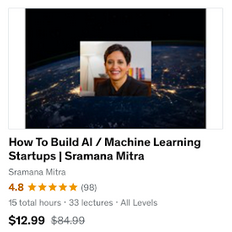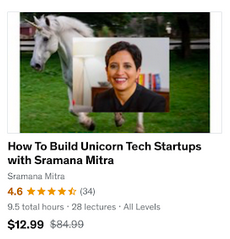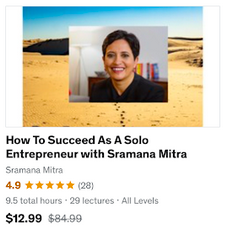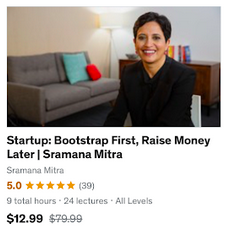Online Education
New 1Mby1M – Udemy Course and Discount Coupon: From Developer to Entrepreneur Case Studies

1Mby1M has had particular success in helping techie entrepreneurs learn the nuances of technology entrepreneurship and making the transition to successful entrepreneurs by learning the business side of startups.
In this new course, From Developer to Entrepreneur Case Studies, we offer case studies of entrepreneurs who have made this transition successfully, in their own words.
Through these case studies, developers who are aspiring entrepreneurs can learn what the journey entails.
Click on the image below to enroll for $12.99 today!
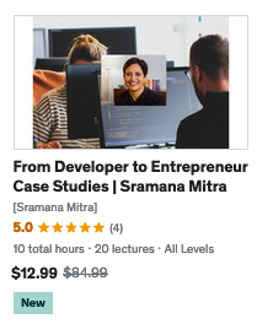
TRY1MBY1MSEP2022D2E
Popular Udemy – 1Mby1M Tech Startup Courses For Sale in August

Our popular Udemy-1Mby1M Tech Startup Courses will be on sale through August! Learn how to put one step before the other on your entrepreneurial journey. Whether you are just starting your entrepreneurship education or interested in startups raising venture capital, we have startup strategies and mentoring advice from successful founders and investors to share with you.
These courses are available throughout the month of August for $12.99 each. Discount coupons for our most popular courses listed below will be automatically applied when you click on the courses to BUY NOW!
Student Developers Bootstrapping with a Paycheck, Then Growing to a Million Users: Ben Spring, CEO of TryHackMe (Part 4)
Sramana Mitra: How many enterprise customers do you have right now?
Ben Spring: Well over a hundred. We’ve been super fortunate to onboard Fortune 500 companies, lots of governments, lots of schools, and colleges. We’ve done some really rewarding work with the education of Scotland to provide training to 14 and 15-year-olds to break into the industry. We’ve been able to expand the number of people using TryHackMe whether you’re a 14-year-old, someone who wants to transition jobs, or someone who’s working in a business.
>>>Student Developers Bootstrapping with a Paycheck, Then Growing to a Million Users: Ben Spring, CEO of TryHackMe (Part 3)
Sramana Mitra: What was happening with the business? Were the conversation rates increasing? Was the number of users increasing and how?
Ben Spring: It was completely organic. We were incredibly lucky. It was just word-of-mouth. We really tried to make a great user experience and understand the user’s problem. At the time, I was constantly iterating on the product and speaking to users. The conversion was still fairly low. I was going into my old job and I just couldn’t stop thinking about TryHackMe. I’d go out on my lunch and I’d be writing emails and doing stuff on the side. I took the jump to leave.
>>>Student Developers Bootstrapping with a Paycheck, Then Growing to a Million Users: Ben Spring, CEO of TryHackMe (Part 2)
Sramana Mitra: When you finished university, what point were you at?
Ben Spring: I can’t remember now. It must have been 10,000 users.
Sramana Mitra: All free still?
Ben Spring: We introduced a pay-as-you-go model. You can pay per course. After talking to users, we found that it wasn’t the best model for us, so we moved over to a subscription model where you pay monthly and you get access to every single thing on TryHackMe.
>>>Student Developers Bootstrapping with a Paycheck, Then Growing to a Million Users: Ben Spring, CEO of TryHackMe (Part 1)

Ben and his co-founder are two techies who started by bootstrapping with a paycheck. With zero marketing budget, they have scaled TryHackMe to a million users and significant revenue.
Sramana Mitra: Let’s start at the very beginning of your journey. Where are you from? Where were you born, raised, and in what kind of background?
Ben Spring: I was born and raised in Portsmouth. I also went to the University of Portsmouth. I have a degree in Computer Science.
>>>Bootstrapping Using Services and Piggybacking from Australia: StoreConnect CEO Mikel Lindsaar (Part 1)

Mikel has built a services company in Australia and spawned six SaaS products out of it. One of them, StoreConnect, is a terrific Bootstrapping by Piggybacking story on top of Salesforce.com. He has exited four of the apps and expects to grow StoreConnect to $100M+ in revenue.
Sramana Mitra: Let’s start at the very beginning of your journey. Where are you from? Where were you born, raised, and in what kind of background?
>>>Solo Entrepreneur Building a Venture Scale EdTech Company from India: Cuemath Founder Manan Khurma (Part 7)
Sramana Mitra: How does the teacher handle so many grades?
Manan Khurma: The teacher handles the students either in a one-to-one class or she does a small group of students. Typically, our teachers will opt for a certain grade segment. Even in a group class, the teacher is essentially teaching one-on-one. Let’s say a teacher has four students in a group at that same hour. Each student would work on their own material. The teacher would hop on from student to student.
>>>
